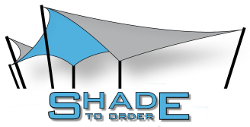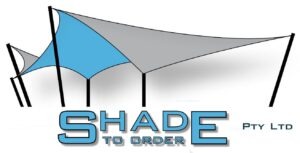FAQs on Shade Structures & Sails
What is PVC Fabric?
Woven polyester with PolyVinylChloride.
Generally using a polyester woven base cloth for shade structures, PVC fabrics are coated with various polymers then a special material to give the material colour, strength and waterproof properties. There are many different top surfaces applied to PVC fabrics ranging from basic acrylic coatings to highly specialised self cleaning finishes like PVDF which prolong the life of the fabric. PVC fabrics are described by their finished weight in grams per square meter. Many different thickness fabrics with different life expectancies are available; generally thicker fabrics have extended life spans. Coloured fabrics are available but usually only in the lighter acrylic coated variants.
What is PTFE Fabric?
Woven fibreglass with PolyTetraFluroEthylene (Teflon like) coating
Unlike PVC, PTFE fabrics use a woven base yarn of glass fibres. The top coating is an extremely high grade Teflon like slick surface that prevents a build up of contaminants, resulting in an extended life span. PTFE fabrics are much more time consuming to manufacture and budgets for PTFE projects are much higher than projects using PVC fabric.
What is a Catenary?
A curved or “scalloped” edge of a fabric structure.
A Catenary is a curved edge generally around 6-10%. Fabric is manufactured with a pocket to insert a stainless steel cable or rod which is fitted with adjusting devices allowing the fine tuning of the length to suit the fully tensioned fabric skin. Without correctly designed catenary edges, the central area of a fabric skin is not under the correct tension and will result in flapping and sagging.
Why do you call them Membranes?
They are 1 piece.
To survive under extreme weather conditions and decades of service, there are many aspects of a tension membrane shade structure that need to be designed correctly. The goal of a tension membrane shade structure is simple: adequate and even tension across the 3D surface of the fabric. To achieve this even tension, several intelligent choices must be made with respect to:
- Fabric choice
- Catenary curves
- Correct Prestress
- Patterning and design
- Adequate 3D shape
- Suitable structural supports
- Link lengths
- Accurate measurement
- Fabric manufacture
Fabric is assembled using large machinery. For PVC structures, high frequency welding results in the fabric joins being as strong as the fabric itself hence the term “Membrane”.
What do you mean by shape?
3 Dimensional curvature.
Curvature in 2 directions at any point on the surface of the fabric. Simplest form is a 4 pointed structure with 2 diagonally opposite points high and 2 diagonally opposite points low, resulting in a “saddle” or “twisted” form, this is commonly known as a Hypar shade structure.
Shape is completely different to pitch or fall. Unlike conventional roofing, the amount of pitch or fall on a fabric structure is irrelevant to it’s 3D shape. The amount of 3D shape on a structure is related to it’s life span. Flat or 2 dimensional structures (regardless of the fabric type) will end up sagging, flapping, loosing their tension and ultimately failing. Structures with a good amount of 3D shape – such as Barrel Vault shade structures, or Conical shade structures – will deal better with high winds, retain their tension better, require less corner and attachment loads to hold their shape, drain water more efficiently and result in surviving for many, many more years.
How much cheaper for a mesh structure?
Not much, if at all!
Fabric choice is governed by many factors. A large range of fabric grades, weights, types and colours exist in the industry. A number of high quality mesh fabrics are available. However any mesh fabric has a number of disadvantages vs a solid waterproof fabric such as:
- Being a mesh fabric, airborne dust and dirt are trapped or filtered, resulting in dirty and ugly appearance.
- More frequent cleaning intervals due to above.
- The build-up of dirt allows for mildew to grow on the surface of the fabric, significantly shortening it life span.
Generally speaking, the manufacturing, all labour, hardware and techniques are all the same for mesh fabrics and waterproof fabrics. The cost of the material is the only difference. Some high quality meshes can actually be more expensive than solid waterproof fabrics.
Do you use Woven Shadecloth?
No, but we do manufacture from architectural PVC and Teflon mesh fabrics.
We operate at the very top end of the market. As shade cloth cannot be welded or joined with any long term method, it is a material that will appear unsightly and fail in a short amount of time. Endless stretching, no structural integrity and extremely poor fire performance are monumental flaws in the characteristic of this material. Woven shade cloth needs to have seams stitched together, this is not ideal as the stitching degrades in the sun and will be chafed by the woven shade cloth fibres. Woven shade cloth sails will “open up” when tensioned and the UV rating will decrease. Shade sail structures manufactured from woven shade cloth are often seen in residential and low budget applications. They WILL stretch out of shape in a very short time and generally have no or very poor fire rating. They are a cheap and nasty solution for any covered area unless it is a very small area and the designer has attempted to generate a 3D shape across the surface, but sadly many are just flat sheets pumping in the wind. The saving gained by using woven shade cloth over a budget architectural fabric on a small shade structure might buy you a meal in a good restaurant. Have a good look at a woven shade cloth stitched shade sail structure that has been in service for more than 6 months, then compare it with a waterproof or mesh tension membrane shade structure that has been high frequency welded together, not stitched, see the difference? Look with your eyes not your cheque book! Shade to Order is here for the long haul and only use materials and methods that we know will give many, many years of trouble free service.
Do you offer a design service?
Absolutely!
Designing fabric shade structures is something we’ve perfected over many years completing 100’s of successful projects in Australia and many overseas countries. The service allows our prospective clients to also benefit from this experience. The fee for the service depends on the details but is more often than not detectable from the cost of the project should it come to fruition.
How far do you travel?
Globally!
There is no corner of the country or globe that we can’t service. All operations are controlled from our Australian head office. We work on projects in the hustle and bustle of Sydney’s CBD to remote, non-populated islands in Thailand. Our international shade structure experience in servicing remote locations combined with our aircraft, semi trailer mobile installation workshop and fleet of vehicles and equipment result in a go anywhere service at your disposal.
Do you design, manufacture and install residential shade structures?
Yes we do!
We have completed many projects for residential shade structures, if the home owner is looking for a quality product that will last for decades we can design build them a beautiful structure.
How long does one of your shade sail structures last?
A long time!
Low maintenance materials and clever design and engineering result in a long term shade sail solution. Fabrics are warranted for up to 15 years and life expectancies in excess of 25 years. Fabric structures can be engineered to withstand the worst Mother Nature can dish out. Many shade sail structures overseas have been in service for 30+ years and are still going strong.
Do you have to clean them often?
No, but it will extend their life.
Maintenance of shade sails and structures is periodically required depending on the amount and type of pollutants as well as the shade sail structures exposure (working environment). Generally speaking a bi-annual wipe over of the fabric surface with water and a sponge is all that is required to give many years of service. Of course more stringent and frequent maintenance helps extend the life and condition of the shade sail structure. Fabrics and supporting 316 stainless steel wire fittings, etc are generally regarded as low maintenance. A correctly designed shade structure with plenty of 3D shape does not usually require re-tensioning at all.
What is the largest structure you have completed?
4,000m2 or nearly 1 whole acre of fabric.
Raymond Terrace Bowling Club engaged us to design, manufacture and install shade sail covers to 2 of their bowling greens in 2006. The result is an international award winning shade sail canopy that is a world first and one of the largest shade sails structures in Australia.
Can you help me visualise the proposed shade sail structure?
Absolutely!
Yes. An important step in determining the customer’s requirements and expectations of a shade sail structure is to represent an impression of the finished product. We can provide renderings on photos, to fully virtual rendered images, walk-through movies, scale models, drawings, etc to give clients full confidence and visualisation of their shade structure. We can even provide shade diagrams representing projected shade outlines at different times of the year, during different times of the day.
Contact Us


